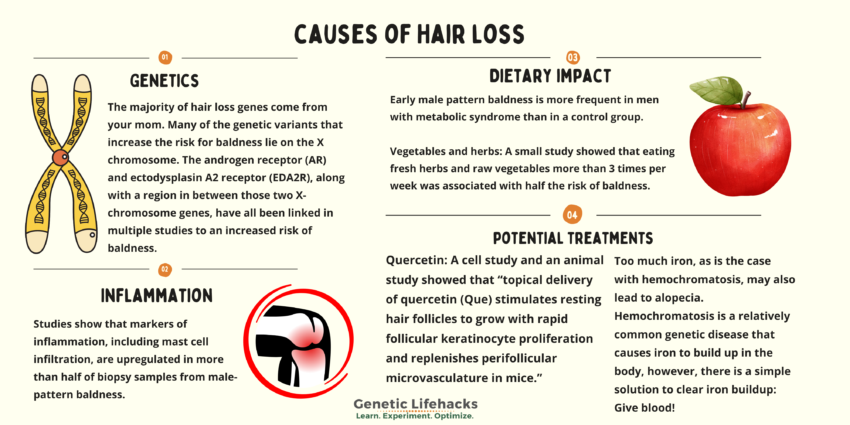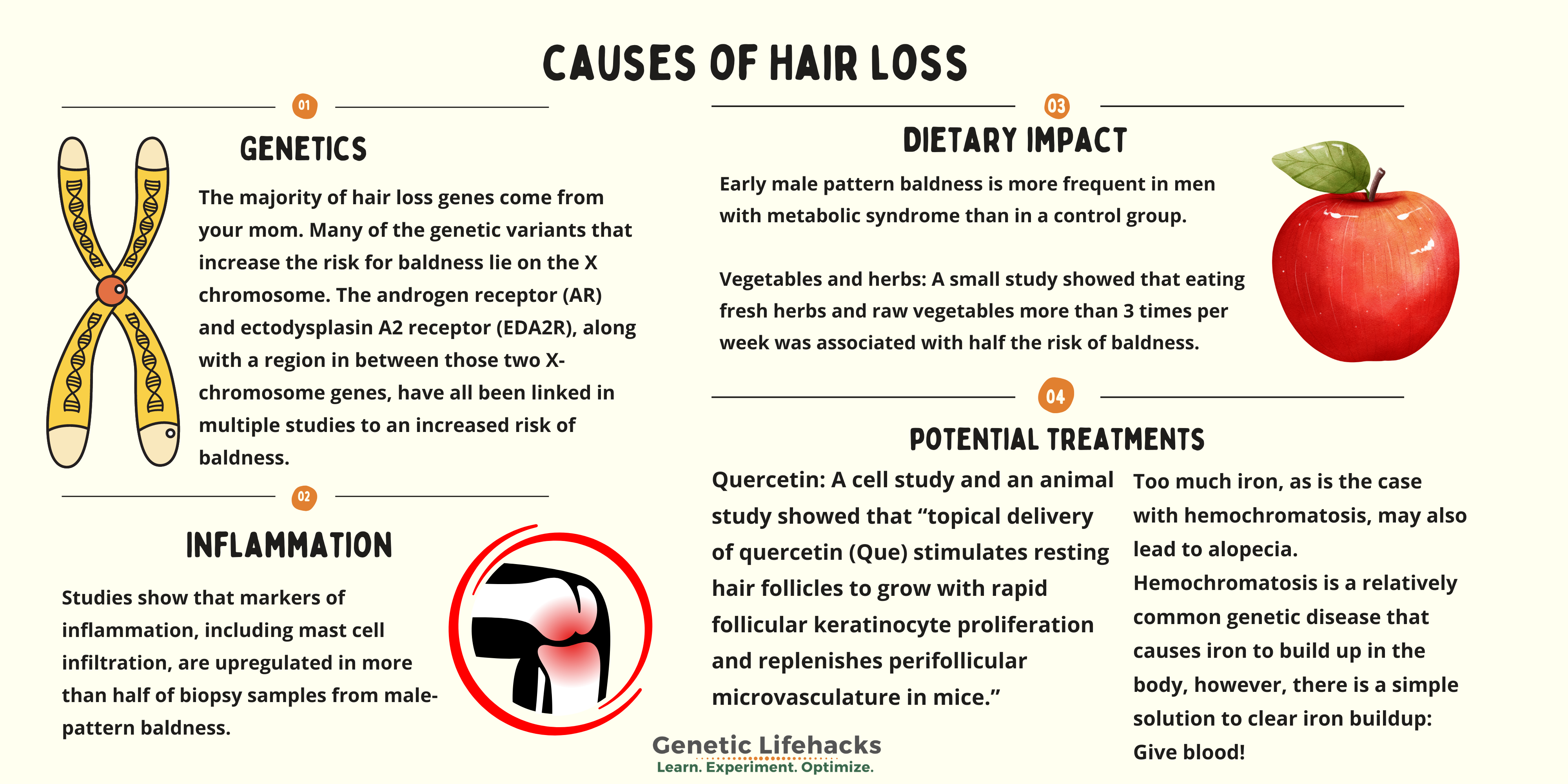Key takeaways:
~ Male pattern baldness, or androgenic alopecia, is a condition that will affect the majority of men of European descent by the age of 50.
~ Male pattern baldness affects women as well, usually to a lesser extent.
~ Genetics plays a big role in balding.
~ Importantly, there are personalized ways to counteract your genetic susceptibility.
Graphical Overview:
What causes male pattern baldness?
A combination of genetics, nutrition, and environmental toxins come together to form the risk factors for pattern baldness.
Twin studies from the early 2000s found 80% of baldness is due to genetics, leaving the other 20% to be blamed on nutrition and toxicant exposure.[ref] More recent studies on the genes involved in balding put heritability at over 90%, leaving little to be blamed on the environment.
Estimates show approximately 80% of men and up to 50% of women will be affected by androgenic alopecia at some point in life.[ref]
- Other estimates put the percentage a little lower, but in general, most estimates show that 50% or more of men are losing their hair by age 50.
- In pre-menopausal women, androgenic alopecia appears more frequently in women with PCOS who have higher androgen hormone levels.
Balding is considered to be a complex trait, with multiple genetic variants involved in the risk of losing your hair.[ref]
Another way of looking at this is that the default is to lose hair as you age, and the people who don’t go bald usually carry a genetic variant that protects against it.
The question is:
Is there anything you can do to prevent hair loss?
There are diet and lifestyle factors that affect how early you lose your hair. Yes, there are medications that work for some people, but the risk of side effects needs to be carefully considered. More natural options with diet, supplements, and lifestyle changes may be a better option for preventing hair loss.
I’m going to dive into the research on how hair grows, why it stops growing, how hormones are involved, what triggers new growth, and how to prevent hair loss.
Stages of hair growth:
Hair growth happens in a continuous process that can be broken into four phases:[ref]
- anagen – growth phase, lasts two to eight years
- catagen – regression phase, the transition from anagen to telogen, lasts two weeks
- telogen – rest phase, last two to three months
- exogen – shedding phase, the termination of telogen and the initiation of anagen
Each individual hair follicle undergoes ten to thirty of these cycles in their lifetime.
Normal hair shedding is 100 to 150 telogen hairs in a day.
In alopecia, the anagen-to-telogen ratio is drastically altered. Importantly, there are a number of factors that can increase the telogen phase follicles.
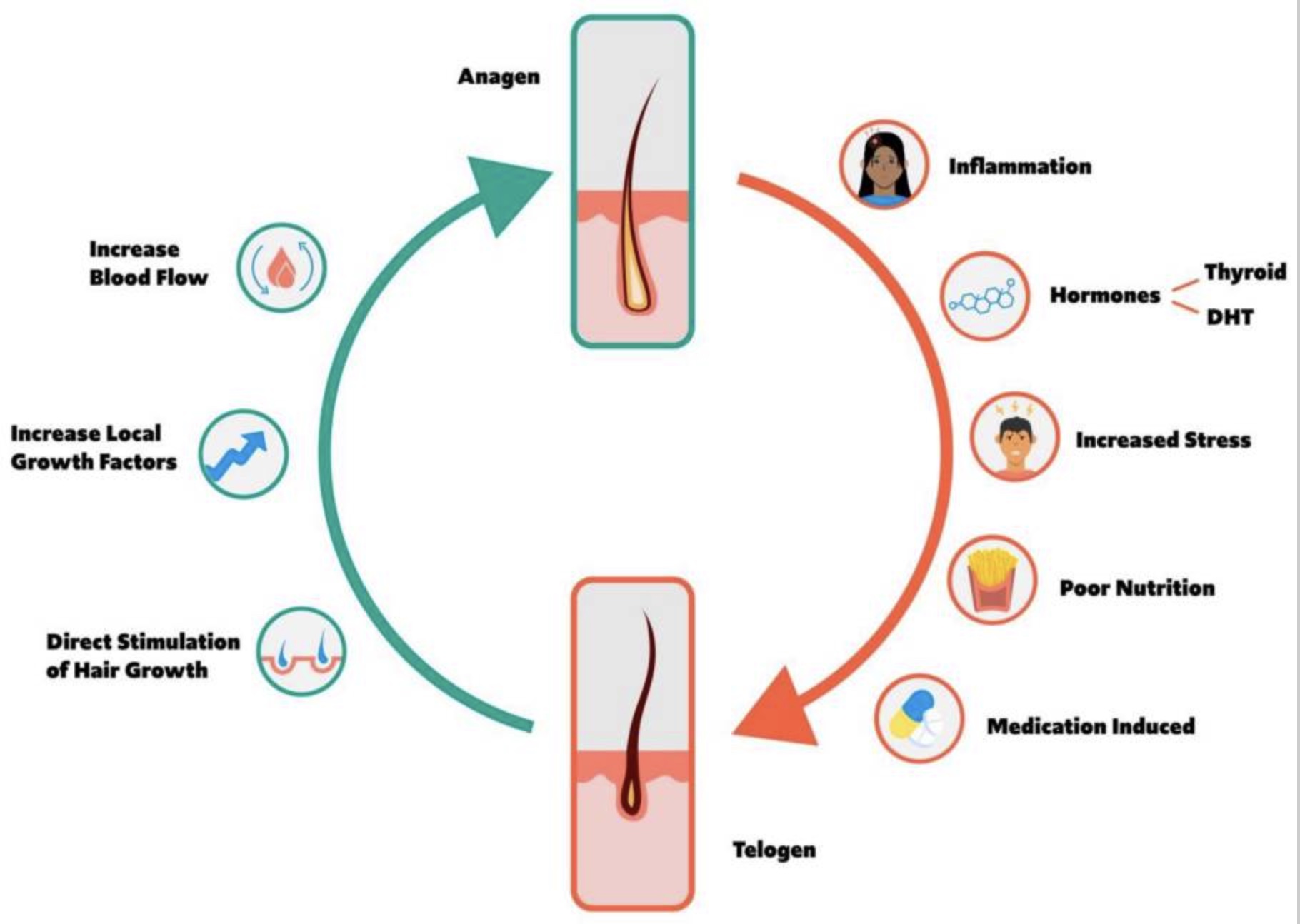
Shifting more hair follicles to the telogen phase (altering the anagen-to-telogen ratio) can be caused by inflammation, androgen hormones (DHT), stress, poor nutrition, or certain medications.
What is androgenic alopecia?
Most research studies on hair loss refer to “androgenic alopecia” or “male pattern baldness”.
More recent studies call it just pattern baldness, which is an indication that this is a problem that affects women as well as men. With 50% of women experiencing hair loss in aging, it makes sense to call it just pattern baldness. Some studies differentiate and refer to female pattern hair loss.
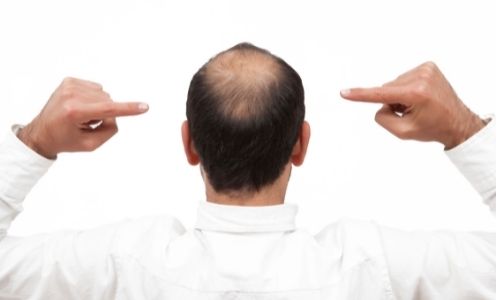
Whatever you call it, this type of balding is characterized by:
- a receding hairline at the temples
- a thinning of hair at the top, rear of the head (vertex)
- generally occurs slowly over months and years
Pattern baldness is different than alopecia areata, which causes rapid and patchy hair loss due to inflammatory or autoimmune reasons. Check out the full article on genetics and alopecia areata to learn more on the causes and solutions.
Hair loss genes come from your mom: X Chromosome link
You may have heard that genes for baldness come from the maternal side, and this is true, to an extent.
Many of the genetic variants that increase the risk for baldness lie on the X chromosome. The androgen receptor (AR) and ectodysplasin A2 receptor (EDA2R), along with a region in between those two X-chromosome genes, have all been linked in multiple studies to an increased risk of baldness.
Being on the X chromosome, males only have one copy of the AR and EDA2R genes, which they inherited from their mom.
However, not all of the genes involved in baldness are on the X chromosome, so your mom may be only partially to blame.
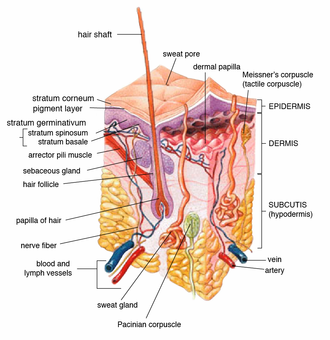
Androgen Receptors (AR) in Pattern Hair Loss
The androgen receptor binds to the androgen hormones, testosterone or dihydrotestosterone.
When an androgen hormone binds to the receptor, it causes a reaction within the cell that eventually results in the transcription of certain genes in the nuclear DNA.
Testosterone -> receptor binding -> genes turned on/off
One product that is produced by androgens binding to the receptor is IGF1-R, which is the insulin-like growth factor 1 receptor. IGF1, which binds to IFG-1R (receptor), is responsible for growth in childhood and muscle growth as an adult. Testosterone binds to the androgen receptor, causing an increase in IGF1 receptors and triggering muscle growth.
Two androgen hormones bind to AR:
- testosterone
- dihydrotestosterone (DHT)
DHT binds more preferentially to the AR receptor than testosterone. And DHT is the focus for male pattern baldness…
High levels of DHT occur in the scalps of men who are balding. Researchers think the high levels of DHT are causing micro-inflammation in the hair follicles, which then results in the miniaturization of the follicles and hair loss.
DHT reduces the anagen phase of hair growth and causes the hair follicles to shrink to the point that hair cannot grow.[ref]
A study of 178 young men with male pattern baldness looked at their androgen hormone levels compared with a control group. The study found that the men who were balding had higher total testosterone, higher free testosterone, and higher DHT levels than controls. But their sex-hormone binding globulin, follicle-stimulating hormone, and luteinizing hormone levels were similar to control. The 178 patients were treated with finasteride, an AR blocker. Of the participants, 136 had a decrease in DHT, testosterone, and free testosterone — along with a reversal of hair loss. Not all men reacted the same to finasteride.[ref]
The study noted that a greater reduction in androgens did not necessarily correlate to more hair growth. Also, there were some men for whom the decrease in androgens did not bring about hair improvements.[ref] More was not better and too much finasteride has adverse effects (more on this below).
The reasons that high DHT levels cause pattern baldness are not completely known. When males go through puberty and testosterone, and DHT levels rise, this is what triggers hair growth all over the body. So why does it decrease hair growth on the head?
Beyond AR and DHT: There’s more to the hair loss story
One theory, proposed by Dr. Ustuner, explained in a 2013 paper theorizes the tightness of the skin across the top of the head is what causes the miniaturization of the hair follicles, resulting in male pattern baldness.[ref]
It is an interesting theory and attempts to explain why high levels of DHT are linked to balding only in certain areas of the scalp.
The circulation in the skin is essential, delivering growth factors, nutrients, and bioactive molecules. Circulation is also needed for removing the metabolic waste products that can cause oxidative stress in the hair follicles. Together, the lack of good microcirculation around the hair follicles could cause hair follicle miniaturization.[ref]
Here is a visual overview from a recent study of the possible reasons for hair follicle disruption and miniaturization:
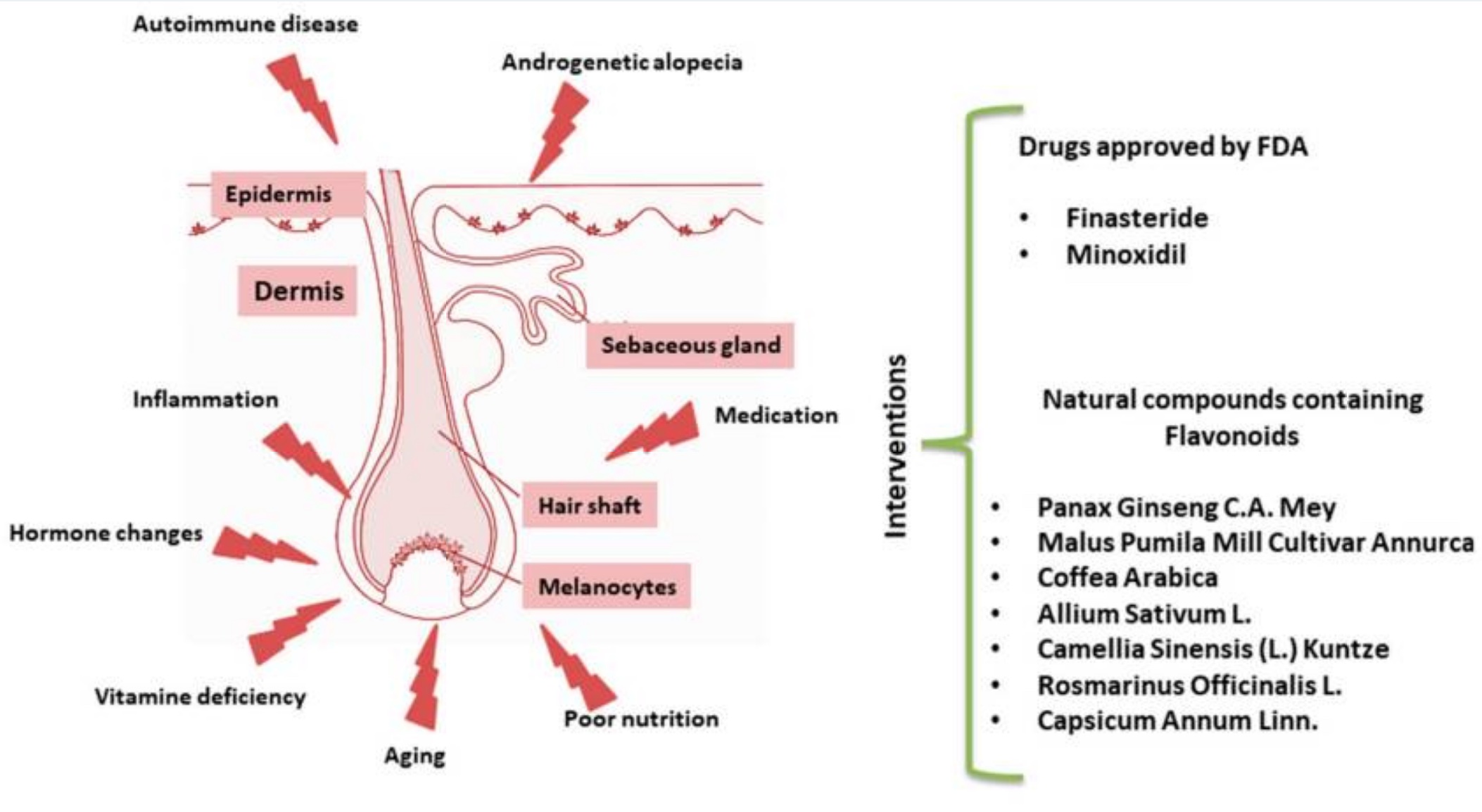
Fresh hair growth is driven by hair follicle stem cells in the follicle bulge. Mechanical stretching activates stem cells and promotes the release of growth factors. The study points to needing a specific amount of strain for a limited duration of time. [ref]
Diet and lifestyle factors involved in hair loss:
Can you blame sugar and a crappy diet for balding? Maybe.
Early male pattern baldness is more frequent in men with metabolic syndrome than in a control group.[ref] This has been shown in a couple of small studies, but none of them really prove that metabolic syndrome causes baldness — vs. just the two conditions being more likely to coincide together.
A meta-analysis of seven studies found that men with early balding had a slightly worse glycolipid profile on average. The conclusion was that this may be similar to the insulin resistance found in women with PCOS.[ref]
A study showed that post-menopausal women with higher insulin levels (insulin >10 mU/l – which is still in the normal range) are at a higher risk for hair thinning.[ref]
Inflammation as a cause of hair loss:
The progression of the anagen phase to an excess of follicles in the telogen phase causes hair loss. Studies show that markers of inflammation, including mast cell infiltration, are upregulated in more than half of biopsy samples from male-pattern baldness. IgE levels can be elevated and there is T cell infiltration around the hair bulb, both pointing towards an increase in inflammatory molecules around the follicle in hair loss. [ref]
Recent research uses the term microinflammation, indicating slow, subtle inflammation in the hair follicle. One possibility is that certain bacteria in the skin microbiome could increase inflammation in the hair follicle. Another option is that chemical stress from irritants, pollution, or UV radiation could increase reactive oxygen species in the hair follicle. The elevated inflammatory cytokines, such as IL-1 and TNF-beta, then can progressively lead to permanent changes to the area where the follicular stem cells reside.[ref]
Is baldness a cause of prostate cancer?
The androgen hormones promote prostate cancer, and finasteride (Propecia) is a medication used both for prostate enlargement and preventing hair loss. Thus, it makes sense to investigate whether prostate cancer is linked to baldness. Here’s what the research shows:
- A meta-analysis investigated 15 different studies on the topic and concluded that no, prostate cancer is not linked to baldness in general.[ref]
- A specific type of balding known as vertex balding (bald spot on the top, back of your head), though, slightly increased the likelihood of prostate cancer.[ref]
- One study shows that baldness is also not linked to prostate size. However, not all of the research agrees on this topic. A second, smaller study did find a link to both prostate size and urine flow.[ref][ref]
Early Hair Loss Genotype Report:
Not a member? Join here. Membership lets you see your data right in each article and also gives you access to the member’s only information in the Lifehacks sections.
🖨 Printable Overview (Members)
Since the majority of men (in most ethnicities) are likely to start balding at some point, these variants are listed to show the minority, which is usually those who are less likely to go bald.
What you are probably hoping for here is to carry several of the genetic variants that decrease the risk of balding…
Intergenetic (between genes) locations: identified in large genetic studies
Check your genetic data for rs1998076 (23andMe v4, v5):
- AA: less than half the normal risk of going bald[ref][ref][ref]
- AG: decreased risk of going bald
- GG: typical
Members: Your genotype for rs1998076 is —.
Check your genetic data for rs2223841 (23andMe v4):
- C/C (or C): much less likely to go bald[ref]
- T/T (or T): typical
Members: Your genotype for rs2223841 is —.
Check your genetic data for rs925391 (23andMe v4):
- G/G (or G): typical
- A/G: decreased risk of early hair loss
- A/A (or A): much less likely to early hair loss[ref]
Members: Your genotype for rs925391 is —.
Check your genetic data for rs6945541 (23andMe v4, v5):
Members: Your genotype for rs6945541 is —.
AR gene: androgen receptor, X chromosome so men only have one copy
Check your genetic data for rs10521339 (23andMe v4):
- A/A (or A): less likely to go bald[ref]
- A/T: less likely to go bald
- T/T (or T): typical
Members: Your genotype for rs10521339 is —.
Check your genetic data for rs6625163 (23andMe v4):
- G/G (or G): less likely to go bald[ref]
- A/G: less likely to go bald
- A/A (or A): typical
Members: Your genotype for rs6625163 is —.
EDA2R gene: A type of tumor necrosis factor receptor, located on the X chromosome near the AR gene. Cell studies show that EDA2R is located in the hair follicle. When stimulated by ectodysplasin, a ligand of the TNF family, it causes apoptosis and premature onset of the catagen phase.[ref]
Check your genetic data for rs1385699 (23andMe v4):
- CC (or C): less likely to go bald[ref]
- CT: less likely to go bald
- T/T (or T): typical
Members: Your genotype for rs1385699 is —.
Check your genetic data for rs1511061 (23andMe v4):
- C/C (or C): less likely to go bald (strongest effect allele in GWAS)[ref]
- C/T: less likely to go bald
- T/T (or T): typical
Members: Your genotype for rs1511061 is —.
C1orf127 gene (unknown function)
Check your genetic data for rs12565727 (23andMe v5):
Members: Your genotype for rs12565727 is —.
SLC14A2 gene: small molecule transporter, in the kidneys, it is a urea transporter.
Check your genetic data for rs10502861 (23andMe v4, v5):
Members: Your genotype for rs10502861 is —.
MAPT-AS1 gene: non-coding RNA, regulates MAPT expression
Check your genetic data for rs12373124 (23andMe v4):
Members: Your genotype for rs12373124 is —.
LINC01432 gene: non-coding RNA
Check your genetic data for rs1160312 (23andMe v4, v5):
- A/A: typical[ref]
- A/G: typical
- G/G: decreased risk of baldness
Members: Your genotype for rs1160312 is —.
IRF4 gene: Controls melanin, hair color -variant mainly found in people of European background giving rise to freckles and sensitivity to the sun (and earlier balding)
VDR gene: Vitamin D receptor
Check your genetic data for rs731236 (23andMe v4, v5; AncestryDNA):
- G/G: increased risk of female pattern hair loss[ref]
- A/G: increased risk of female pattern hair loss
- A/A: typical
Members: Your genotype for rs731236 is —.
Lifehacks: Research-based options for preventing hair loss
The rest of this article is for Genetic Lifehacks members only. Consider joining today to see the rest of this article.
Member Content:
An active subscription is required to access this content.
Join Here for full access to this article, genotype reports, and much more!
Already a member? Log in below.
Related Articles and Topics:
Genetic Causes of Male Infertility
Almost 10% of couples worldwide struggle with infertility. Learn more about your genetic susceptibility and dig deeper into the lifestyle factors that could affect your sperm.
Top 10 Genes to Check in Your Genetic Raw Data
Wondering what is actually important in your genetic data? These 10 genes have important variants with a big impact on health. Check your genes (free article).
Your need for riboflavin (B2): MTHFR and other genetic variants
Riboflavin (Vitamin B2) is a water-soluble vitamin that is a cofactor for many enzymes in the body. To put it in simpler terms: riboflavin is vitally important!
ABCC11 gene: Ear wax and no body odor
The ABCC11 gene determines both the type of earwax a person has and whether they have no armpit or body odor.
References:
Aourag, Nassim, et al. “Can We Predict Prostate Size by Scoring Baldness? The Relationship of Androgenic Alopecia and Lower Urinary Tract Symptoms.” Central European Journal of Urology, vol. 72, no. 1, 2019, pp. 39–43. PubMed Central, https://doi.org/10.5173/ceju.2018.1889.
Arias-Santiago, Salvador, et al. “Androgenetic Alopecia as an Early Marker of Benign Prostatic Hyperplasia.” Journal of the American Academy of Dermatology, vol. 66, no. 3, Mar. 2012, pp. 401–08. ScienceDirect, https://doi.org/10.1016/j.jaad.2010.12.023.
Banger, Harmeet Singh, et al. “Is Early Onset Androgenic Alopecia a Marker of Metabolic Syndrome and Carotid Artery Atherosclerosis in Young Indian Male Patients?” International Journal of Trichology, vol. 7, no. 4, Dec. 2015, pp. 141–47. PubMed, https://doi.org/10.4103/0974-7753.171566.
Bassino, Eleonora, et al. “Protective Role of Nutritional Plants Containing Flavonoids in Hair Follicle Disruption: A Review.” International Journal of Molecular Sciences, vol. 21, no. 2, Jan. 2020. www.ncbi.nlm.nih.gov, https://doi.org/10.3390/ijms21020523.
—. “Protective Role of Nutritional Plants Containing Flavonoids in Hair Follicle Disruption: A Review.” International Journal of Molecular Sciences, vol. 21, no. 2, Jan. 2020. www.ncbi.nlm.nih.gov, https://doi.org/10.3390/ijms21020523.
Cannarella, Rossella, et al. “Glycolipid and Hormonal Profiles in Young Men with Early-Onset Androgenetic Alopecia: A Meta-Analysis.” Scientific Reports, vol. 7, no. 1, Aug. 2017, p. 7801. www.nature.com, https://doi.org/10.1038/s41598-017-08528-3.
Fertig, Raymond M., et al. “Sexual Side Effects of 5-α-Reductase Inhibitors Finasteride and Dutasteride: A Comprehensive Review.” Dermatology Online Journal, vol. 23, no. 11, Nov. 2017, p. 13030/qt24k8q743.
He, Huadong, et al. “Male Pattern Baldness and Incidence of Prostate Cancer: A Systematic Review and Meta-Analysis.” Medicine, vol. 97, no. 28, July 2018, p. e11379. PubMed, https://doi.org/10.1097/MD.0000000000011379.
—. “Male Pattern Baldness and Incidence of Prostate Cancer: A Systematic Review and Meta-Analysis.” Medicine, vol. 97, no. 28, July 2018, p. e11379. PubMed, https://doi.org/10.1097/MD.0000000000011379.
Heilmann-Heimbach, Stefanie, et al. “Meta-Analysis Identifies Novel Risk Loci and Yields Systematic Insights into the Biology of Male-Pattern Baldness.” Nature Communications, vol. 8, Mar. 2017, p. 14694. PubMed Central, https://doi.org/10.1038/ncomms14694.
Hillmer, Axel M., Sandra Hanneken, Sibylle Ritzmann, Tim Becker, Jan Freudenberg, Felix F. Brockschmidt, Antonia Flaquer, Yun Freudenberg-Hua, Rami Abou Jamra, Christine Metzen, Uwe Heyn, Nadine Schweiger, Regina C. Betz, Bettina Blaumeiser, Jochen Hampe, Stefan Schreiber, Thomas G. Schulze, Hans Christian Hennies, Johannes Schumacher, Peter Propping, Thomas Ruzicka, Sven Cichon, Thomas F. Wienker, Roland Kruse, and Markus M. Nothen. “Genetic Variation in the Human Androgen Receptor Gene Is the Major Determinant of Common Early-Onset Androgenetic Alopecia.” American Journal of Human Genetics, vol. 77, no. 1, July 2005, pp. 140–48. PubMed, https://doi.org/10.1086/431425.
Hillmer, Axel M., Sandra Hanneken, Sibylle Ritzmann, Tim Becker, Jan Freudenberg, Felix F. Brockschmidt, Antonia Flaquer, Yun Freudenberg-Hua, Rami Abou Jamra, Christine Metzen, Uwe Heyn, Nadine Schweiger, Regina C. Betz, Bettina Blaumeiser, Jochen Hampe, Stefan Schreiber, Thomas G. Schulze, Hans Christian Hennies, Johannes Schumacher, Peter Propping, Thomas Ruzicka, Sven Cichon, Thomas F. Wienker, Roland Kruse, and Markus M. Nöthen. “Genetic Variation in the Human Androgen Receptor Gene Is the Major Determinant of Common Early-Onset Androgenetic Alopecia.” The American Journal of Human Genetics, vol. 77, no. 1, July 2005, pp. 140–48. www.cell.com, https://doi.org/10.1086/431425.
Hillmer, Axel M. , et al. “Genetic Variation in the Human Androgen Receptor Gene Is the Major Determinant of Common Early-Onset Androgenetic Alopecia.” American Journal of Human Genetics, vol. 77, no. 1, July 2005, pp. 140–48. PubMed Central, https://www.ncbi.nlm.nih.gov/pmc/articles/PMC1226186/.
Lai, Ching-Huang, et al. “Androgenic Alopecia Is Associated with Less Dietary Soy, Higher Blood Vanadium and Rs1160312 1 Polymorphism in Taiwanese Communities.” PLoS ONE, vol. 8, no. 12, Dec. 2013, p. e79789. PubMed Central, https://doi.org/10.1371/journal.pone.0079789.
Lee, Solam, et al. “Adverse Sexual Effects of Treatment with Finasteride or Dutasteride for Male Androgenetic Alopecia: A Systematic Review and Meta-Analysis.” Acta Dermato-Venereologica, vol. 99, no. 1, Jan. 2019, pp. 12–17. PubMed, https://doi.org/10.2340/00015555-3035.
Li, Rui, Felix F. Brockschmidt, Amy K. Kiefer, Hreinn Stefansson, Dale R. Nyholt, Kijoung Song, Sita H. Vermeulen, Stavroula Kanoni, Daniel Glass, Sarah E. Medland, Maria Dimitriou, Dawn Waterworth, Joyce Y. Tung, Frank Geller, Stefanie Heilmann, Axel M. Hillmer, Veronique Bataille, Sibylle Eigelshoven, Sandra Hanneken, Susanne Moebus, Christine Herold, Martin den Heijer, et al. “Six Novel Susceptibility Loci for Early-Onset Androgenetic Alopecia and Their Unexpected Association with Common Diseases.” PLOS Genetics, vol. 8, no. 5, May 2012, p. e1002746. PLoS Journals, https://doi.org/10.1371/journal.pgen.1002746.
Li, Rui, Felix F. Brockschmidt, Amy K. Kiefer, Hreinn Stefansson, Dale R. Nyholt, Kijoung Song, Sita H. Vermeulen, Stavroula Kanoni, Daniel Glass, Sarah E. Medland, Maria Dimitriou, Dawn Waterworth, Joyce Y. Tung, Frank Geller, Stefanie Heilmann, Axel M. Hillmer, Veronique Bataille, Sibylle Eigelshoven, Sandra Hanneken, Susanne Moebus, Christine Herold, Martin den Heijer, et al. “Six Novel Susceptibility Loci for Early-Onset Androgenetic Alopecia and Their Unexpected Association with Common Diseases.” PLoS Genetics, vol. 8, no. 5, May 2012, p. e1002746. PubMed, https://doi.org/10.1371/journal.pgen.1002746.
—. “Six Novel Susceptibility Loci for Early-Onset Androgenetic Alopecia and Their Unexpected Association with Common Diseases.” PLoS Genetics, vol. 8, no. 5, May 2012, p. e1002746. PubMed Central, https://doi.org/10.1371/journal.pgen.1002746.
Liang, Bo, et al. “Genetic Variants at 20p11 Confer Risk to Androgenetic Alopecia in the Chinese Han Population.” PLoS ONE, vol. 8, no. 8, Aug. 2013, p. e71771. PubMed Central, https://doi.org/10.1371/journal.pone.0071771.
Liu, Fan, et al. “Prediction of Male-Pattern Baldness from Genotypes.” European Journal of Human Genetics, vol. 24, no. 6, June 2016, pp. 895–902. PubMed Central, https://doi.org/10.1038/ejhg.2015.220.
—. “Prediction of Male-Pattern Baldness from Genotypes.” European Journal of Human Genetics, vol. 24, no. 6, June 2016, pp. 895–902. PubMed Central, https://doi.org/10.1038/ejhg.2015.220.
—. “Prediction of Male-Pattern Baldness from Genotypes.” European Journal of Human Genetics, vol. 24, no. 6, June 2016, pp. 895–902. PubMed Central, https://doi.org/10.1038/ejhg.2015.220.
Marcińska, Magdalena, et al. “Evaluation of DNA Variants Associated with Androgenetic Alopecia and Their Potential to Predict Male Pattern Baldness.” PLoS ONE, vol. 10, no. 5, May 2015, p. e0127852. PubMed Central, https://doi.org/10.1371/journal.pone.0127852.
—. “Evaluation of DNA Variants Associated with Androgenetic Alopecia and Their Potential to Predict Male Pattern Baldness.” PLoS ONE, vol. 10, no. 5, May 2015, p. e0127852. PubMed Central, https://doi.org/10.1371/journal.pone.0127852.
—. “Evaluation of DNA Variants Associated with Androgenetic Alopecia and Their Potential to Predict Male Pattern Baldness.” PLoS ONE, vol. 10, no. 5, May 2015, p. e0127852. PubMed Central, https://doi.org/10.1371/journal.pone.0127852.
Matilainen, Veikko, et al. “Hair Loss, Insulin Resistance, and Heredity in Middle-Aged Women. A Population-Based Study.” Journal of Cardiovascular Risk, vol. 10, no. 3, June 2003, pp. 227–31. PubMed, https://doi.org/10.1097/01.hjr.0000070200.72977.c6.
Piraccini, B. M., and A. Alessandrini. “Androgenetic Alopecia.” Giornale Italiano Di Dermatologia E Venereologia: Organo Ufficiale, Societa Italiana Di Dermatologia E Sifilografia, vol. 149, no. 1, Feb. 2014, pp. 15–24.
Pirastu, Nicola, et al. “GWAS for Male-Pattern Baldness Identifies 71 Susceptibility Loci Explaining 38% of the Risk.” Nature Communications, vol. 8, Nov. 2017, p. 1584. PubMed Central, https://doi.org/10.1038/s41467-017-01490-8.
Prodi, Dionigio Antonio, et al. “EDA2R Is Associated with Androgenetic Alopecia.” Journal of Investigative Dermatology, vol. 128, no. 9, Sept. 2008, pp. 2268–70. ScienceDirect, https://doi.org/10.1038/jid.2008.60.
Richards, J. Brent, et al. “Male-Pattern Baldness Susceptibility Locus at 20p11.” Nature Genetics, vol. 40, no. 11, Nov. 2008, pp. 1282–84. PubMed, https://doi.org/10.1038/ng.255.
—. “Male-Pattern Baldness Susceptibility Locus at 20p11.” Nature Genetics, vol. 40, no. 11, Nov. 2008, pp. 1282–84. www.nature.com, https://doi.org/10.1038/ng.255.
Ustuner, Emin Tuncay. “Cause of Androgenic Alopecia: Crux of the Matter.” Plastic and Reconstructive Surgery Global Open, vol. 1, no. 7, Nov. 2013, p. e64. PubMed Central, https://doi.org/10.1097/GOX.0000000000000005.
Zhang, Yingchun, et al. “Serum Levels of Androgen-Associated Hormones Are Correlated with Curative Effect in Androgenic Alopecia in Young Men.” Medical Science Monitor : International Medical Journal of Experimental and Clinical Research, vol. 24, Oct. 2018, pp. 7770–77. PubMed Central, https://doi.org/10.12659/MSM.913116.

